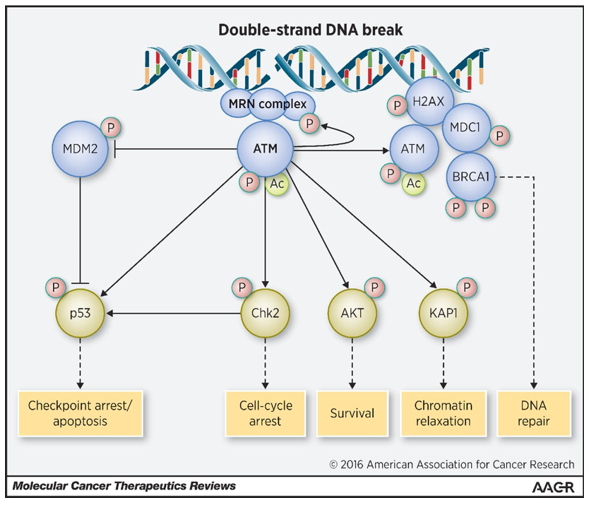
Our promise to you:
Guaranteed product quality, expert customer support.
 24x7 CUSTOMER SERVICE
24x7 CUSTOMER SERVICE
 CONTACT US TO ORDER
CONTACT US TO ORDER
ATM Gene Editing 
Ataxia-capillary dilation mutation (ATM) is a member of the phosphatidylinositol (PI) -3-kinase gene family, which is activated after binding to DNA double-stranded breaks (DSB). When activated, it phosphorylates and activates several proteins involved in DNA repair, such as the Nijmegen Break Syndrome protein (Nbs-1).
Structurally, ATM contains five domains, a HEAT repeat domain, a FRAP-ATM-TRRAP (FAT) domain, a kinase domain (KD), a PIKK regulatory domain (PRD), and a FAT-C terminal (FATC) domain. HEAT repeats bind directly to the C-terminus of NBS1. The FAT domain interacts with the kinase domain of ATM to stabilize the C-terminal region of ATM itself. The KD domain restores kinase activity, while the PRD and FATC domains regulate kinase activity.
- ATM and DNA damage
The function of ATM is to sense the DNA breaks induced during the S phase and coordinate the cellular response in response to damage. Its genetic mutation results in a rare autologous hereditary disorder, ataxia capillary dilation (AT), manifested by increased cancer susceptibility, including 20% to 30% lifetime lymph, stomach, breast, central nervous system risk, skin, and other cancers. Besides, numerous studies have demonstrated ATM plays an important role in signaling related to inducing aging and regulating the state of aging.
 Figure 1: ATM function in repair of double-stranded DNA breaks (Michael Choi. 2016).
Figure 1: ATM function in repair of double-stranded DNA breaks (Michael Choi. 2016).
- ATM as a target for diseases therapy
Studies have shown that ATM inhibitors (ATMi) can act like human EGFR cells in human tumor cells, thereby inhibiting the growth of tumor cells. Tumor cells are sensitive to IR, suggesting that ATMi as an alternative method may have anti-cancer effects on EGFRi inhibiting tumor cells and promote radiation therapy. Anyway, ATM provides possibilities for future therapeutic targets in the fields of aging and cancer.
ATM Gene Editing Service
CRISPR/Cas9 PlatformCB is a global biotechnology company that provides high-quality CRISPR/Cas9 gene-editing products and services to genomics and proteomics researchers in a wide range of markets including analysis, biomarker discovery and drug discovery. Tell us the gene name, we can help you effectively regulate your target genes editing (including deletion, insertion or point mutation, etc.) in vivo and in vitro using the CRISPR/Cas9 system.
- Details of our ATM gene editing service
| Project Workflow | Service |
| gRNA design and synthesis, donor DNA design and synthesis (if needed) | ATM Gene Editing Cell Line Generation Service |
| CRISPR/Cas9 vector construction | |
| Transfection into the cell lines you’re interested | |
| Select the high expression cells and sort monoclonal cell | |
| Validate the right edited monoclonal cells by PCR and sequencing | |
| Delivery the stable cells and a final report | |
| gRNA design and synthesis, donor DNA design and synthesis (if needed) | ATM Gene Editing Animal Model Generation Service |
| CRISPR/Cas9 vector construction | |
| Microinjection | |
| Breed the founder mice, and validation | |
| Delivery the F0 or F1 mice |
What kind of models we deal with?
| Model Types | |
| Blood Lineage Cells | RAW264.7, HMC1.2, K562, U937, etc. |
| Cancer Cell Lines | HEK293, HEK293T, Hela, MCF7, Neuro2a, HepG2, U87, etc. |
| Stem Cells | iPSC |
| Other Cell Lines | NIH3T3, MCF10, HEME, SW10, etc. |
| Animal models | Mouse, rat, rabbit, zebrafish, C. elegans, etc. |
CRISPR/Cas9 PlatformCB has excellent quality management and quality assurance capabilities, providing the best gene-editing services and products for academic research, biotechnology research, and drug discovery. To support your research, we provide you with end-to-end ATM gene-editing services from strategy design to final models. If you have any questions, please feel free to contact us.
Related Products at CRISPR/Cas9 PlatformCB
| CATALOG NO. | PRODUCT NAME | INQUIRY |
| CCKM0032 | B6J-Atmem1Cd | Inquiry |
References
- Aird KM. et al. ATM couples replication stress and metabolic reprogramming during cellular senescence. Cell Rep. 2015; 11(6):893–901.
- Bar RS. et al. Extreme insulin resistance in ataxia telangiectasia. N Engl J Med. 1978; 298(21):1164–71.
- Candice Martino. et al. ATM-Mutated Pancreatic Cancer: Clinical and Molecular Response to Gemcitabine/Nab-Paclitaxel After Genome-Based Therapy Resistance. Pancreas. 2020; 49(1):143-147.
- Cosentino C. et al. ATM activates the pentose phosphate pathway promoting anti-oxidant defense and DNA repair. EMBO J. 2011; 30(3):546–55.
- Ditch S & Paull TT. The ATM protein kinase and cellular redox signaling: beyond the DNA damage response. Trends Biochem Sci. 2013; 37(1):15–22.
- Fang EF. et al. Nuclear DNA damage signaling to mitochondria in ageing. Nat Rev Mol Cell Biol. 2016; 17(5):308–21.
- Janet Stavnezer. et al. Molecular Mechanism of Class Switch Recombination. Molecular Biology of B Cells. 2004:307-326.
- Michael Choi. et al. ATM Mutations in Cancer: Therapeutic Implications. Molecular Cancer Therapeutics. 2016; 15(8):1781-1791.
- Venturina Stagni. et al. Ataxia-Telangiectasia Mutated Kinase in the Control of Oxidative Stress, Mitochondria, and Autophagy in Cancer: A Maestro With a Large Orchestra. Front Oncol. 2018; 8:73.
- Zhan H. et al. Ataxia telangiectasia mutated (ATM)-mediated DNA damage response in oxidative stress-induced vascular endothelial cell senescence. J Biol Chem. 2010; 285(38):29662–70.